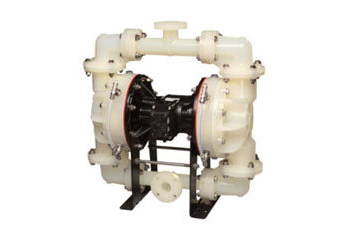Diaphragm assembly for air-operated diaphragm pumps
The diaphragm assembly of the pneumatic diaphragm pump is one of the core components of the pump. It is directly involved in the liquid delivery process and bears the working pressure of the pump. The following is a detailed analysis of the diaphragm assembly of the pneumatic diaphragm pump:
1. Composition of the diaphragm assembly
The diaphragm assembly is usually composed of a diaphragm sheet, a diaphragm pressure plate, a diaphragm support ring and other components. These components are precisely processed and assembled to form a sealed chamber that can reciprocate.
Diaphragm sheet: It is the most critical component in the diaphragm assembly. It directly contacts and transports the liquid. The diaphragm sheet needs to have good corrosion resistance, wear resistance, temperature resistance and other properties to ensure the long-term stable operation of the pump. Common diaphragm sheet materials include rubber, polytetrafluoroethylene (PTFE), fluororubber, etc.
Diaphragm pressure plate: used to fix the diaphragm sheet to prevent it from displacement or damage during operation. The diaphragm pressure plate is usually connected to the pump body through fasteners such as bolts to ensure the sealing and stability of the diaphragm sheet.
Diaphragm support ring: located at the edge of the diaphragm sheet, it plays a supporting and positioning role. It can help the diaphragm to maintain the correct position in the pump body and prevent it from deforming or breaking under high pressure.
2. Working principle of diaphragm assembly
During the working process of pneumatic diaphragm pump, the diaphragm assembly realizes the liquid delivery in the following ways:
Compressed air drive: When the compressed air enters the pneumatic motor, its pressure energy is converted into mechanical energy to drive the diaphragm pump plate to reciprocate.
Suction and discharge: When the diaphragm pump plate moves outward, negative pressure is generated in the pump chamber, the suction valve opens, and the liquid is sucked into the pump; then, when the diaphragm pump plate moves inward, the liquid in the pump chamber is compressed and pushed to the discharge valve to discharge the liquid.
Sealing and isolation: The diaphragm assembly forms a sealed chamber in the pump body, isolating the liquid from other parts of the pump, avoiding leakage and contamination of the liquid.
3. Diaphragm assembly maintenance and care
In order to ensure the long-term stable operation of the pneumatic diaphragm pump, the diaphragm assembly needs to be regularly maintained and serviced:
Inspection and replacement: Regularly check the wear of the diaphragm. If it is found to be severely worn or broken, a new diaphragm should be replaced in time.
Cleaning and lubrication: Regularly clean the various parts of the diaphragm assembly to remove dirt and impurities attached to it; at the same time, lubricate the parts that need lubrication to reduce wear and friction.

Tightening and adjustment: Check the tightness of the diaphragm pressure plate and the support ring to ensure that they are firmly and reliably connected to the pump body; at the same time, adjust the position and angle of the diaphragm assembly as needed to ensure its normal operation.




